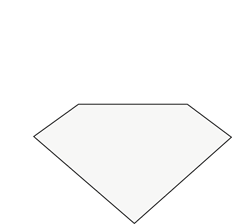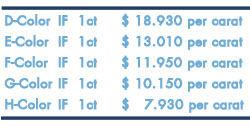London Antwerp Diamonds Ltd.
6, Laybourne House
Admirals Way
Canary Wharf
London E14 9UH
UK
tel.: 0044(0)20 7193 6052
welcome@londonantwerpdiamonds.com
| Home > Diamond Education > Colour | |
The exception to the rule is the Fancy Yellow (canary) diamond, which is beautiful bright yellow and priced similar to white diamonds. There are four colour grades of Fancy Yellow (Fancy Light Yellow, Fancy Yellow, Fancy Intense Yellow and Fancy Vivid Yellow) with each deeper shade bringing a higher price. Keep in mind that the colour illustrated on these colour
charts is exaggerated in order to see the difference on your computer monitor.
Actual colour differences are much more subtle. Some people are more sensitive to the colour of diamonds. What may appear slightly yellow to you may look white (lack of colour) to another person, so it will take a higher colour grade to satisfy you. The average shopper doesn't even notice yellow tints in mounted diamonds having a grade from G to J because the increasing nuances of colour are so slight. What you see as the "colour" of a diamond is really a combination of bodycolour, brilliance, and dispersion. Bodycolour is the inherent colour of the stone and is caused by the different colours of light that are absorbed by the stone. Brilliance is the total amount of light returned to the eye by reflections from within the stone and from its surface. This often is referred to as the "brightness" and "life" of the stone and determined largely by the cut of the diamond. The better the cut, the more light is reflected within the diamond and back through the top of the diamond. Disperson Keep in mind that colour is graded with the diamond upside down in controlled lighting conditions. What you see looking a diamond face up is impacted more by the brilliance (cut of the diamond) than the colour of the diamond. colour grading is not an exact science and even the certification laboratories will disagree about a diamond's colour grade. Remember, colour grades are a range and at one point a high H is equal to a low G colour. The distinction between colour grades is so fine that sometimes the same stone will get different colour grades if sent to the same grading laboratory a second time. Colour and
price In the near colourless range (G, H, I and J), there is a more noticeable difference. While G colour is very close to colourless, J colour is very close to faint yellow. Most J colour diamonds have a slight yellow tint. Diamonds with H and I colour grade diamonds appear white and are great values because they are more plentiful than the colourless grades and therefore are less expensive. To know what colour grade you are comfortable with, go look at some diamonds side by side. Remember to be comparing HRD or IGI certified diamonds so you can be sure of the colour you are actually seeing. It is also helpful to be looking at similar sizes and shapes. Some shapes, like rounds, are brighter than others. Princess cut diamonds tend to be deep and darker looking than a round with the same colour grade. Diamonds with greater carat weights tend to show more colour than smaller diamonds with the same colour grade. Beware
of the jeweler that tells you a higher clarity diamond makes it appear whiter.
Clarity has no impact on colour and this misinformation was meant to trick you
into buying low colour, high clarity stones they have in inventory and can not
get rid of. | |


 Dispersion,
or fire, is a spreading and separating of white light into its component hues,
much like a prism. Even a colourless diamond will flash rainbow colours due to
dispersion. Both brilliance and dispersion are desirable for beauty but are not
measured or documented on any certification. Have a look at the figure on the
right to see the illustration of dispersion (courtesy of IGI)
Dispersion,
or fire, is a spreading and separating of white light into its component hues,
much like a prism. Even a colourless diamond will flash rainbow colours due to
dispersion. Both brilliance and dispersion are desirable for beauty but are not
measured or documented on any certification. Have a look at the figure on the
right to see the illustration of dispersion (courtesy of IGI)